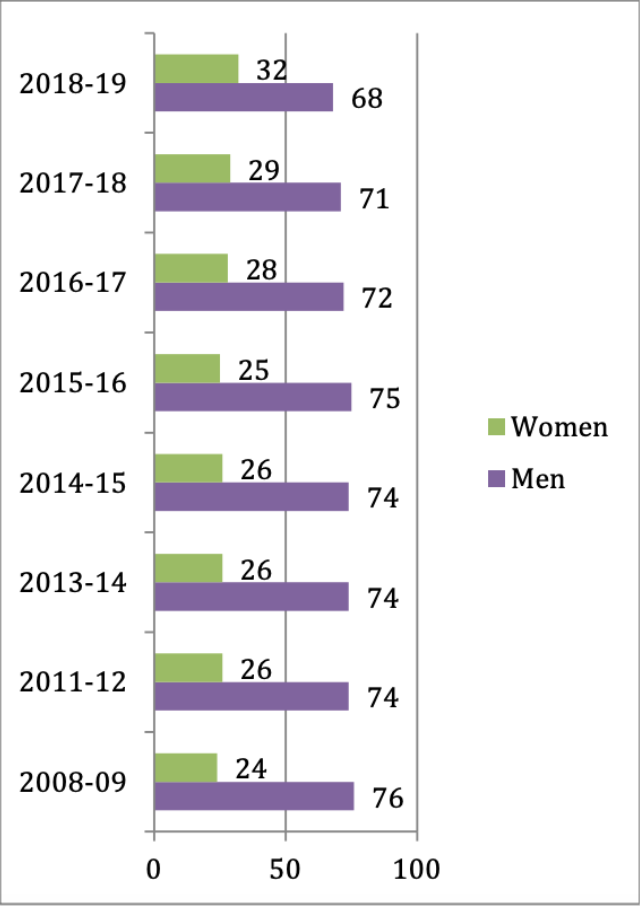A study published this month by the Center for the Study of Women in Television and Film indicates substantial progress for women’s inclusion in independent films over the past year.
The study, based on an examination of 970 independent films, found that the most drastic change in women’s representation was among writers and executive producers—both of which increased six percentage points from last year. Women now make up 32 percent of both writers and executive producers in the films surveyed.

A historical comparison of percentages of behind-the-scenes women working on independent films. (Center for the Study of Women in Television and Film)
The average representation of women among all directors, writers, producers, executive producers, editors and cinematographers also reached 32 percent this year—still drastically unequal, but marking a “recent historic high,” according to the study.
The report “Indie Women: Behind-the-Scenes Employment of Women in Independent Film” was headed by Executive Director Martha M. Lauzen, who both celebrated the progress and recognized the shortcomings.
“After many years of tracking stubbornly stagnant numbers,” Lauzen said in a statement, “this year women achieved healthy gains in a number of key behind-the-scenes roles. But despite these increases, it is important to note that women remain dramatically underrepresented, with independent films employing more than twice as many men as women in these roles.”
Lauzen’s study also shows a significant lack of progress in the exposure of women’s films: Independent movies directed by men were screened twice as often by film festivals as those directed by women. And even though women comprise 33 percent of independent film directors (up from 29 percent last year), only 17 percent of such films have a female cinematographer and only 27 percent have one or more female writers.
Such discrepancies are amplified in the realm of science fiction and superhero films, according to a recent study by the Women’s Media Center (WMC), an organization founded by Jane Fonda, Robin Morgan and Gloria Steinem. The study, a collaboration with BBC America, is titled “The Superpowering Women in Science Fiction and Superhero Film: A 10-Year Investigation.”
“Behind the camera, change is excruciatingly slow,” according to WMC’s press release. Most notably, it found that three percent of science fiction and superhero films made during the recent decade were directed by women—as compared to 33 percent of independent films.
A lack of gender representation can be seen on screen as well: 86 percent of superhero and science fiction films have a male lead or male/female co-leads, while only 14 percent of films have a solo female lead.
“Representation matters,” said Julie Burton, president and CEO of WMC, in a press release, “and impressive box office numbers show that women filmmakers make great films, and women and girls lead the charge to watch them. Despite that, our analysis shows we still have a long way to go for sci-fi and superhero films to reflect inclusive perspectives and portrayals of women and girls.”
The study noted in its conclusion that “with filmmakers such as Ava DuVernay, Patty Jenkins, Cathy Yan, Claire Denis, and Jennifer Yuh Nelson continuing to redefine what women can do behind the camera, and with their films drawing impressive box office numbers, there is no reason why there should not be more women directing both superhero and science fiction films.”
Lauzen emphasized the importance of putting women in directors’ chairs, to create a ripple effect of employment of more women behind-the-scenes.
“Films with at least one woman director also had substantially higher percentages of women writers, editors, and cinematographers,” Lauzen said. For instance, according to the indie film study, 72 percent of writers on female-directed films were women. That number shrank to just 11 percent when it came to films directed by only men.
“These differences are dramatic and demonstrate that when women direct films, they disrupt traditional hiring patterns,” Lauzen explained, “installing women as writers, editors, and cinematographers. This tendency counters the widespread and seemingly intractable bias that has favored male networks.”
Organizations such as Women and Hollywood, a partner of Ms., devote their resources to working towards gender equality in entertainment through education and advocacy. Their ultimate goal is to achieve diverse representation in entertainment and media, and to encourage women of all backgrounds to feel included in the industry.
“Really, what this is about,” said Women and Hollywood founder and publisher Melissa Silverstein, “is access to opportunities and access to capital. Women have to be able to operate at the highest levels of the business, and that has been an area that has been very cut off for women and also people of color.”
“At this time of enormous, sweeping, social change,” said Pat Mitchell, Chair of the Board of Directors of the WMC, “it’s important that television and film provide an abundance of roles and role models for diverse girls and young women.”





